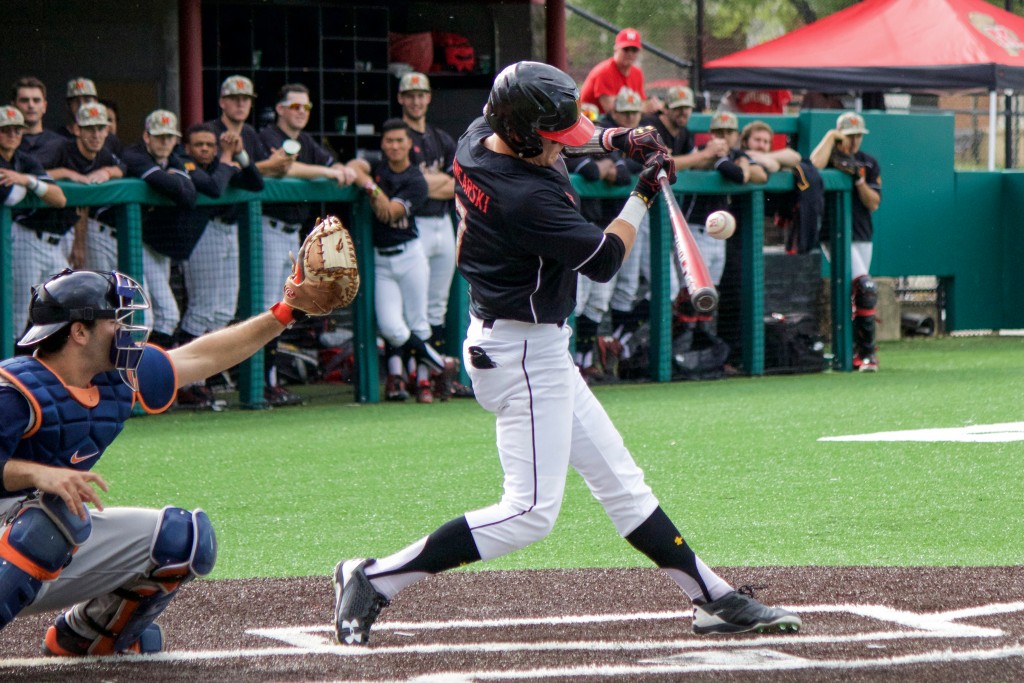When facing Stetson ace and first-round prospect Logan Gilbert last weekend, Maryland baseball coach Rob Vaughn knew his lineup might strike out a lot.
However, against a much weaker Richmond squad in a midweek game Tuesday, the Terps continued to struggle putting the ball in play.
Battling pitchers throwing in the 80s rather than Gilbert’s big-league quality fastball, Maryland struck out 13 times, including five with runners on base.
Maryland is averaging 8.6 strikeouts per game this year compared to 7.7 last season. Terps hitters strike out in 26.4 percent of at-bats, a rise of 3.7 percentage points from 2017. Their 215 punchouts are a conference high and have played a significant role in the team’s 3-7 skid over its last 10 games.
“When you’re facing Logan Gilbert, that’s going to happen. You’re going to get your punches,” Vaughn said. “That’s not a knock of [Richmond’s staff], it’s just the reality of the situation. We’re not seeing 95 to 97 today with a swing-and-miss breaking ball, and to punch out [13] times is something that can’t happen.”
[Read more: Six-run sixth dooms Maryland baseball in 10-3 loss to Richmond]
The Terps struck out at least 10 times in seven of their last 10 games. When Gilbert accumulated 10 punchouts last Friday, Vaughn criticized his team for the way they went down. Vaughn expected Gilbert’s ability to mix up pitches to lead to swings and misses, but was disappointed that four of the punchouts were looking.
He didn’t know if his squad was overthinking due to its recent slump or trying to guess Gilbert’s pitches ineffectively. During its five-game losing streak earlier this month, Maryland’s lineup was hitting 10-for-74 with runners on base. Center fielder Zach Jancarski believes an overly passive approach doomed the Terps on Tuesday.
[Read more: Maryland baseball suffers 12-3 series-opening defeat to Stetson]
“Sometimes when we struggle, we maybe take a pitch that we can hammer early in the count,” Jancarski said. “Sometimes you get one pitch to hit, and if you don’t hit it, then you kind of put yourself against a wall.”
Jancarski said the Terps work through a series of offensive drills in practice, including pitching machines and human-thrown balls. He anticipates plenty of work facing pitches entering the zone an on angle to force batters to go the other way with swings.
“We haven’t been great with two strikes this year, and that’s something that is huge,” Vaughn said. “You watch really good teams, they’re not punching out 10 or 12 times a game.”
As the Terps scuffle to plate runners, Jancarski said it may have affected the approach at the plate. Trailing by seven runs after Maryland’s bullpen imploded in the sixth inning Tuesday, Jancarski thought some batters pressed too hard in their at-bats, swinging at poor pitches.
Even before the deficit, the Terps missed chances to extend innings and secure a lead of their own. Designated hitter Richie Schiekofer struck out with two runners on with one out in the second, and catcher Justin Vought went down looking to strand two more in the fourth.
With Maryland’s batting average resting 42 points below last year’s mark, the rise in strikeouts have been a key contributor to the Terps’ 12-13 start.
“Obviously, striking out [13] times a game here, that’s not going to win many ballgames,” Jancarski said. “Really good teams, they find a way to at least get the ball in play, shoot something up the middle or the other way with two strikes.”



